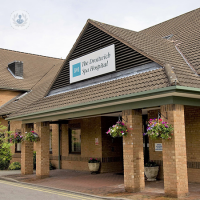Thrombosis
What is thrombosis?
Thrombosis is the formation of a blood clot inside a blood vessel (vein or artery) which can obstruct the flow of blood throughout the body.
There are different types of thrombosis, which are classified depending on where the thrombosis is located:
- Phlebothrombosis
Phlebothrombosis is the formation of a blood clot inside the vein, without inflammation but with a great capacity for detachment, given that it is poorly attached to the vessel wall. These types of blood clot usually affect the deeper venous system (of the leg, mostly) as deep vein thrombosis. In advanced cases where the blood clot breaks off and travels to other organs, phlebothrombosis can cause a stroke or a pulmonary embolism.
In the case of thrombophlebitis, the blood clot is usually attached to the venous wall and results in swelling, tenderness and redness in the affected area of the body. Thrombophlebitis commonly affects the smaller, superficial veins in your legs.
- Arterial thrombosis
Arterial thrombosis is the formation of a blood clot in the arteries, usually in the brain or the heart, which can obstruct blood flow, resulting in a stroke, a heart attack, critical limb ischaemia or a transient ischaemic attack if the thrombosis is left untreated. These are all medical emergencies which require immediate care.

What are the symptoms of thrombosis?
The symptoms of phlebothrombosis are:
- Swelling in one leg
- Pain or tenderness
- Numbness
- Red or blue discoloration in the skin
- Shortness of breath
- Chest pain
The symptoms of thrombophlebitis are:
- Swelling and redness in the arm or leg
- Some pain
- Feeling of warmth
- Tenderness
What causes thrombosis?
Thrombosis in the vein is caused by either venous stasis (the slow movement of blood which can happen during long periods of immobility), hypercoagulability (an increased tendency for your blood to create clots due to an imbalance of clotting chemicals in the blood) or damage to the vein.
Most cases of thrombosis in the artery are the result of atherosclerosis, the hardening and narrowing of artery walls, which damages the artery.
There are also certain risk factors that can increase the chances of a blood clot forming, including:
- Older age
- Pregnancy
- Certain contraceptive pills
- Hormone replacement therapy
- Immobility (travel, hospital stays, injuries, sedentary lifestyle)
- Obesity
- Smoking
- Infection
- Autoimmune diseases
- Leg injury
- Major surgery
- Inherited blood disorders
- Previous blood clots
How is thrombosis diagnosed?
To diagnose thrombosis, a doctor will check and order:
Can a thrombosis be prevented?
The emergence of a thrombosis can be prevented by controlling the normal fluidity of the bloodstream and preventing the formation of clots. Therefore, in certain cases such as those recovering from surgery or when a person is bedridden for a period, the administration of heparin or oral anticoagulants are recommended. In general, it is recommended to drink large amounts of water and carry out certain exercises to contract the muscles of the legs and thus stimulate the flow of blood.
There are also measures you can take to avoid a thrombosis forming, including:
- Keeping fit and exercising regularly
- Losing weight if you are overweight
- Eating healthily
- Stop smoking and drinking in excess
- If you sit for long periods, take regular breaks to walk around and stretch your legs
- Wear flight socks on long flights or car journeys (these can be bought from a pharmacy)
- Managing other health issues such as diabetes and high cholesterol
How is a thrombosis treated?
Treating a thrombosis depends on the patient's overall health, age and medical history as well as the type of thrombosis detected.
In the case of a large or life-threatening blood clot, treatment options include: anticoagulant medication (blood thinners) that prevent blood clot growth; thin tubes (catheters) to widen the blood vessel; a mesh tub (stent) to hold the vessel open; clot-dissolving medications; compression stockings and varicose vein removal.
In patients with a thrombosis in the deep venous system of the leg (deep vein thrombosis), an emergency hospitalisation is required because if the clot detaches it, it could result in a pulmonary embolism or stroke.
Over time, the body will naturally dissolve the blood clot on its own. This can be a partial or a full removal of the clot.
What does recovery after a thrombosis involve?
After thrombosis, some people may experience difficulties trying to adjust their lifestyle to the intake of anticoagulants so recovery should be gradual. You should start by carrying out light daily activities without straining yourself unncessarily and then return to exercise, but doing so very slowly. Most thrombosis symptoms will improve within a few days of taking anticoagulant medication.
How long do I need to take anticoagulant medicine for?
How long you need to take anticoagulant medication for is dependant on the reason for it. For most people, treatment with anticoagulants will be lifelong.
If you are recommended anticoagulants, it is important that you tell your doctors, pharmacists, dentists and nurses that you are taking anticoagulant medication. This is because certain medications and dietary changes can affect how anticoagulants work. The majority of anticoagulants are especially not suitable for pregnancy, so ObGyn specialists should be notified too.
There is a high risk of excessive bleeding with anticoagulant medication. Signs of excessive bleeding include long nose bleeds, gums that bleed, serious bruising, vomiting or coughing up blood and increased menstrual bleeding. Seek immediate medical attention if you are involved in a car accident, have a head trauma or experience prolonged bleeding and you are taking anticoagulants.
Is there a risk for recurrent thrombosis?
The risk of developing recurrent blood clots is determined by each patient's individual characteristics and the cause behind the thrombosis. Howevere, if you have had an unprovoked (not caused by anything) episode of thrombosis, it is very likely that you will go on to experience another blood clot the next few months or years after the first thrombosis. Factors that increase your risk of recurrent thrombosis include: a history of blood clots, genetics; acquired thrombophilia and cancer.
What is travel-related thrombosis?
People who travel frequently and for a long time, such as for an overseas international trip, are at an increased risk for developing deep vein thrombosis (DVT). This is because the risk for DVT occurs more often during air travel, in a small space where it is hard to stand up and move around. The majority of people who develop travel-associated thrombosis also have other pre-existing risk factors that contribute to the onset of thrombosis.
What is haemorrhoid thrombosis?
Thrombosed haemorrhoids develop when an internal or an external haemorrhoid fills with blood clots inside, becoming thrombosed and eventually ruptured once straining causes internal pressure to increase.
What is the relationship between thrombosis and haemostasis?
While thrombosis and haemostasis are both related to coagulation within blood vessels, haemostasis is the body's natural blood clotting mechanism - part of the healing process - which works to prevent excessive bleeding after a trauma such as an injury. Haemostasis can be exaggerated, resulting in thrombosis, or disrupted, causing haemorrhage. Thrombosis, on the other hand, is the formation of blood clots inside a blood vessel, blocking the flow of blood.
















